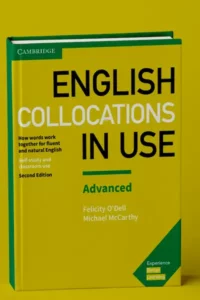English Collocations in Use Advanced presents and practises hundreds of collocations in typical contexts to help you improve your written and spoken English.
It also includes tips on learning strategies and ways to avoid common learner errors. The book is informed by the Cambridge International Corpus to make sure that the collocations taught are the most frequent and useful for students at each level.
What is a collocation?
Collocation means a natural combination of words; it refers to the way English words are closely associated with each other. For example, pay and attention go together, as do commit and crime; blond goes with hair and heavy with rain.
Why learn collocations?
You need to learn collocations because they will help you to speak and write English in a more natural and accurate way. People will probably understand what you mean if you talk about making a crime or say there was very hard rain this morning, but your language will sound unnatural and might perhaps confuse. Did you mean that there was a lot of rain or perhaps that there was a hailstorm?
Learning collocations will also help you to increase your range of English vocabulary. For example, you’ll find it easier to avoid words like very or nice or beautiful or get by choosing a word that fits the context better and has a more precise meaning. This is particularly useful if you are taking a written exam in English and want to make a good impression on the examiners. In advanced level exams, marks are often specifically awarded for the appropriate handling of collocations.
At an advanced level an appreciation of collocation can also be helpful in terms of appreciating other writers’ use of language. Skilled users of the language may choose to create effects by varying the normal patterns of collocation, with the aim of either startling or amusing their audience.
This technique is particularly popular with poets, journalists and advertisers. From an appreciation of the way in which creative writers play with language, you may then even want to move on to use words in more original ways yourself. You are more likely to be able to do this effectively if you have assimilated the standard patterns of language use presented in this book.
How were the collocations in this book selected?
The collocations presented in this book were mainly selected from those identified as significant by the CANCODE corpus of spoken English, developed at the University of Nottingham in association with Cambridge University Press, and the Cambridge International Corpus of written and spoken English (now known as the Cambridge English Corpus). We also made extensive use of the Cambridge Learner Corpus, a corpus of student language which showed us what kind of collocation errors learners tend to make.
These corpora show that there are many thousands of collocations in English. So how could we select which ones would be most useful for you to work on in this book?
Firstly, of course, we wanted to choose ones that you might want to use in your own written and spoken English. So, in the unit Health and medicine we include, for example, shake off a cold and respond well to treatment but not grumbling appendix, which is a strong collocation, but one which – we hope – most of you will not feel the need for.
Secondly, we decided it would be most useful for you if we focused on those collocations which are not immediately obvious. A pretty girl, a modern car or to buy a ticket are all collocations, but they are combinations which you can easily understand and produce yourself without any problems. So we deal here with less obvious word combinations, for instance, flatly contradict (not strongly contradict) and bitter enemies (not serious enemies).
Some of you may have already used our English Collocations in Use targeted at intermediate learners. In general, we have tried to avoid focusing on collocations that we dealt with in that book. An exception is with collocations that the Cambridge Learner Corpus highlighted as causing frequent problems for students, even in advanced level exams. We felt that it would be useful to draw attention to such collocations again, even if we had dealt with them previously.
Idioms can be seen as one type of collocation. We deal with them separately in English Idioms in Use, and so do not focus on them here.
How is the book organised?
The book has 60 two-page units. The left-hand page presents the collocations that are focused on in the unit. You will usually find examples of collocations in typical contexts with, where appropriate, any special notes about their meaning and their usage. The right-hand page checks that you have understood the information on the left-hand page by giving you a series of exercises that practise the material just presented.
The units are organised into different sections. First we start with important information relating to learning about collocations in general. Then there is a section focusing on different types of collocation. The rest of the book deals with collocations that relate to particular topics such as Student life or Film and book reviews, concepts such as Sound or Difficulty, and functions such as Cause and effect or Comparing and contrasting.
The book has a key to all the exercises and an index which lists all the collocations we deal with, and indicates the units where they can be found.
How should I use this book?
It is strongly recommended that you work through the six introductory units first, so that you become familiar with the nature of collocations and with how best to study them. After that, you may work on the units in any order that suits you.

